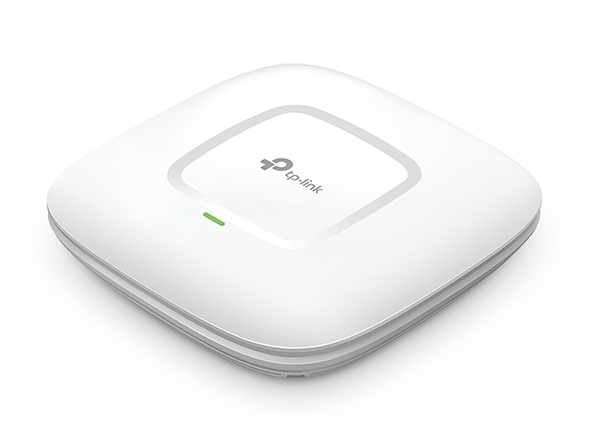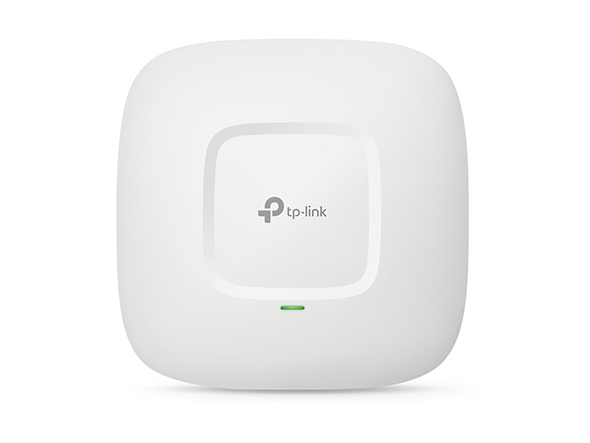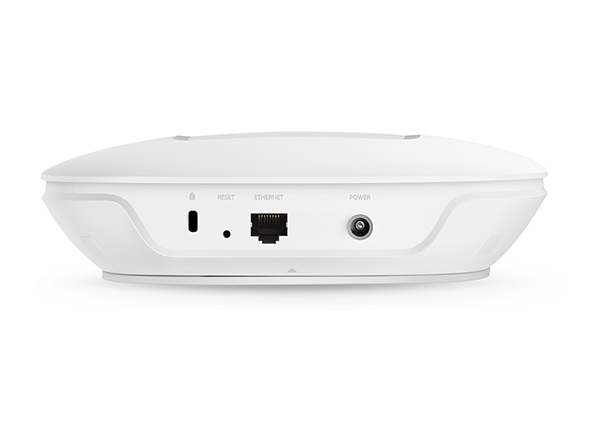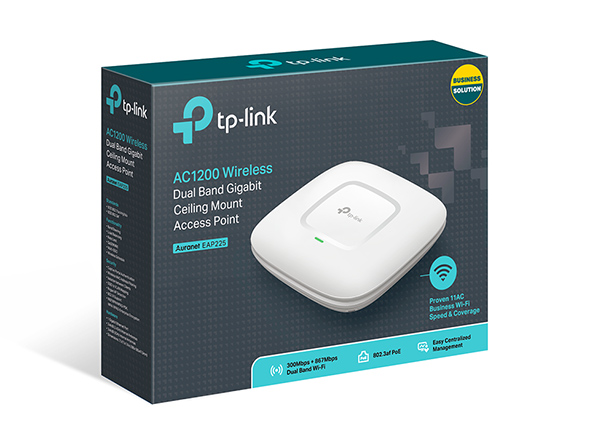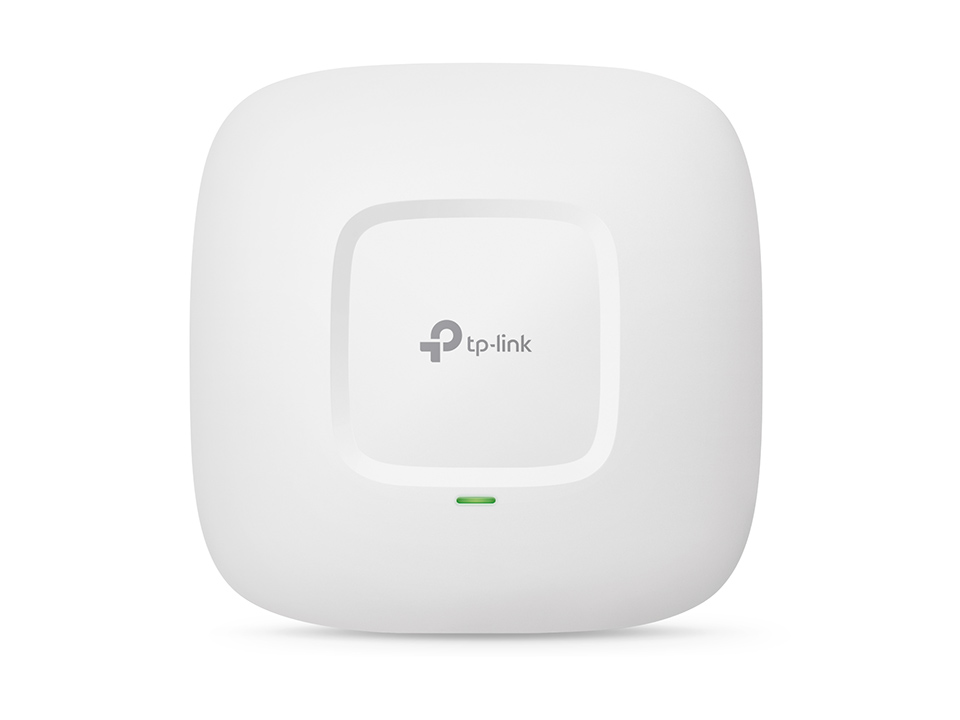AC1200 Wireless Dual Band Gigabit Ceiling Mount Access Point
- Simultaneous 300Mbps on 2.4GHz and 867Mbps on 5GHz totals 1167Mbps Wi-Fi speeds
- Cloud centralized management and Omada app for ultra convenience and easy management
- Compatibility with 802.3af PoE support makes deployment effortless and flexible
- Secure guest network along with multiple authentication options (SMS/Facebook Wi-Fi/ Voucher, etc.) and abundant wireless security technologies.
- Band Steering Automatically moves dual band devices onto the wider 5GHz band for faster connections
- Schedules can be set so access points automatically reboot and Wi-Fi turns on/off at the times you choose
An Affordable Business-Class
802.11ac Wi-Fi Solution

Related Cases
-
Regional Hospital No.1
Providing Wi-Fi for Regional Hospital No.1 of the Tyumen Region
Regional Hospital No.1
Providing Wi-Fi for Regional Hospital No.1 of the Tyumen Region
“TP-Link Wi-Fi solution provided the Regional Hospital No.1 with Internet access for the patients, as well as enterprise Wi-Fi network to facilitate the Smart-medicine concept. The solution, offered by the partner “First integrator”, is easily scalable and allows integration in other hospital units in the long term.” -
Shuraa Facilities Management LLC
Shuraa Facilities Management LLC Chooses TP-link for Wireless Service Deployments
Shuraa Facilities Management LLC
Shuraa Facilities Management LLC Chooses TP-link for Wireless Service Deployments
“The hotel has overcome some of its Wi-Fi internet connectivity for guests following the implementation of TP-Link’s solutions. In addition, it has been able to provide connectivity in more than 100 guest apartments without compromising of guest comfort and experience.”
| HARDWARE FEATURES | |
|---|---|
| Interface | Gigabit Ethernet (RJ-45) Port×1 (Support IEEE802.3af PoE) |
| Physical Security Lock | Yes |
| Button | Reset |
| Power Supply | 802.3af/A PoE |
| Power Consumption | EU: 10.5 W US: 12.6W |
| Dimensions | 7.1 × 7.1 × 1.9 in. (180 × 180 × 47.5 mm) |
| Antenna Type | 2 Internal Omni2.4GHz: 4dBi5GHz: 4dBi |
| Mounting | Ceiling /Wall Mounting (Kits included) |
| WIRELESS FEATURES | |
|---|---|
| Wireless Standards | IEEE 802.11ac/n/g/b/a |
| Frequency | 2.4GHz and 5GHz |
| Signal Rate | 5GHz:Up to 867Mbps2.4GHz:Up to 300Mbps |
| Wireless Functions | Multiple SSIDs (Up to 16 SSIDs, 8 for each band)Enable/Disable Wireless RadioAutomatic Channel AssignmentTransmit Power Control (Adjust Transmit Power on dBm)QoS(WMM)Seamless RoamingBand SteeringLoad BalanceRate LimitReboot ScheduleWireless ScheduleWireless Statistics based on SSID/AP/Client |
| Wireless Security | Captive Portal AuthenticationAccess ControlWireless Mac Address FilteringWireless Isolation Between ClientsSSID to VLAN MappingRogue AP Detection802.1X Support |
| Transmission Power | CE:≤20dBm(2.4GHz,EIRP)≤23dBm(5GHz,EIRP)FCC:≤24dBm(2.4GHz)≤22dBm(5GHz) |
| MANAGEMENT | |
|---|---|
| Omada Cloud Access | Yes |
| Omada App | Yes |
| Omada Cloud Controller | Yes |
| Omada Controller Software | Yes |
| Email Alerts | Yes |
| LED ON/OFF Control | Yes |
| Management MAC Access Control | Yes |
| SNMP | v1,v2c |
| System Logging Local/Remote Syslog | Local/Remote Syslog |
| SSH | Yes |
| Web-based Management | HTTP/HTTPS |
| L3 Management | Yes |
| Multi-site Management | Yes |
| Management VLAN | Yes |
| OTHERS | |
|---|---|
| Certification | CE, FCC, RoHS |
| Package Contents | AC1200 Wireless Dual Band Gigabit Ceiling Mount Access Point EAP225Power AdapterMounting KitsInstallation Guide |
| System Requirements | Microsoft Windows XP, Vista, Windows 7, Windows 8, Windows10, Linux |
| Environment | Operating Temperature: 0℃~60℃ (32℉~144℉)Storage Temperature: -40℃~70℃ (-40℉~158℉)Operating Humidity: 10%~90% non-condensingStorage Humidity: 5%~90% non-condensing |
*Maximum wireless signal rates are the physical rates derived from IEEE Standard 802.11 specifications. Actual wireless data throughput and wireless coverage are not guaranteed and will vary as a result of 1) environmental factors, including building materials, physical objects, and obstacles, 2) network conditions, including local interference, volume and density of traffic, product location, network complexity, and network overhead, and 3) client limitations, including rated performance, location, connection, quality, and client condition.
